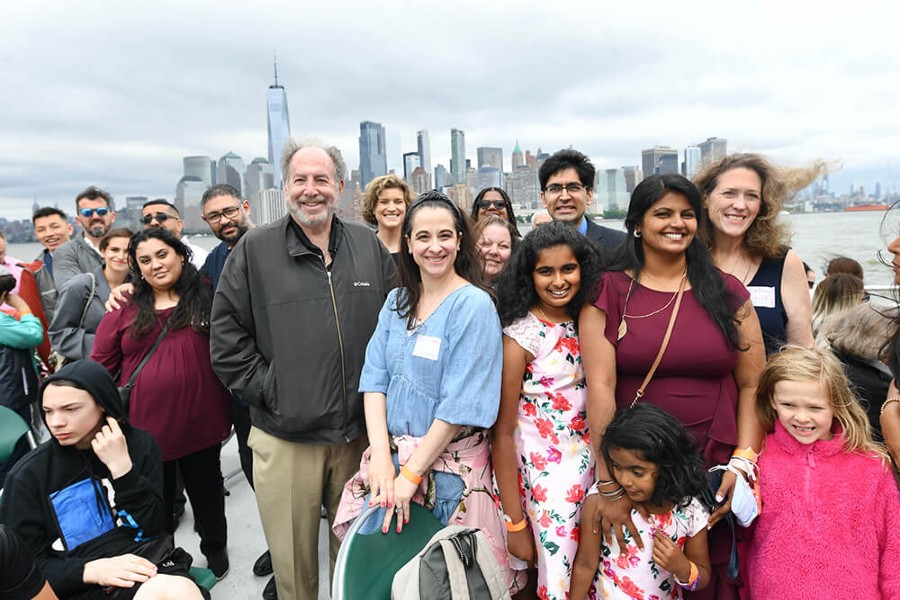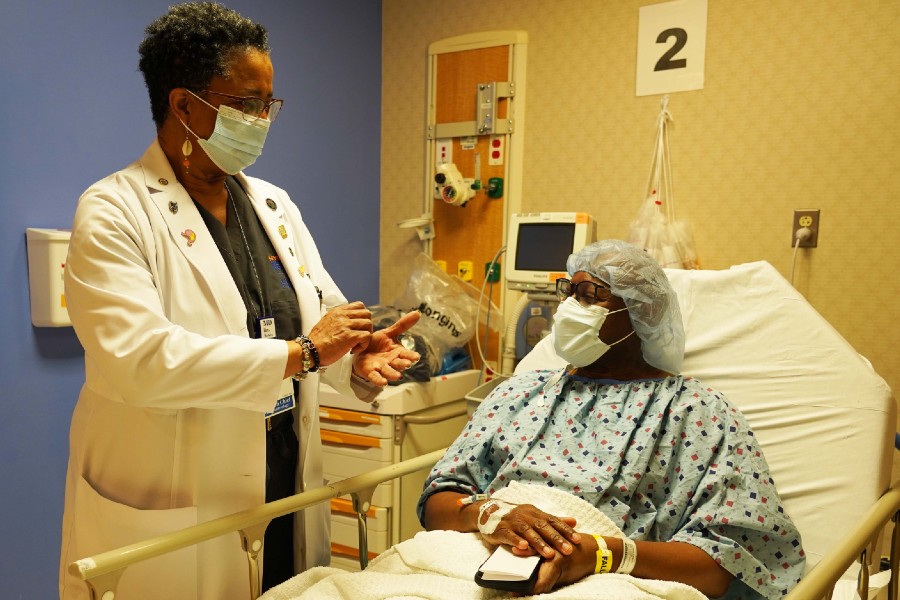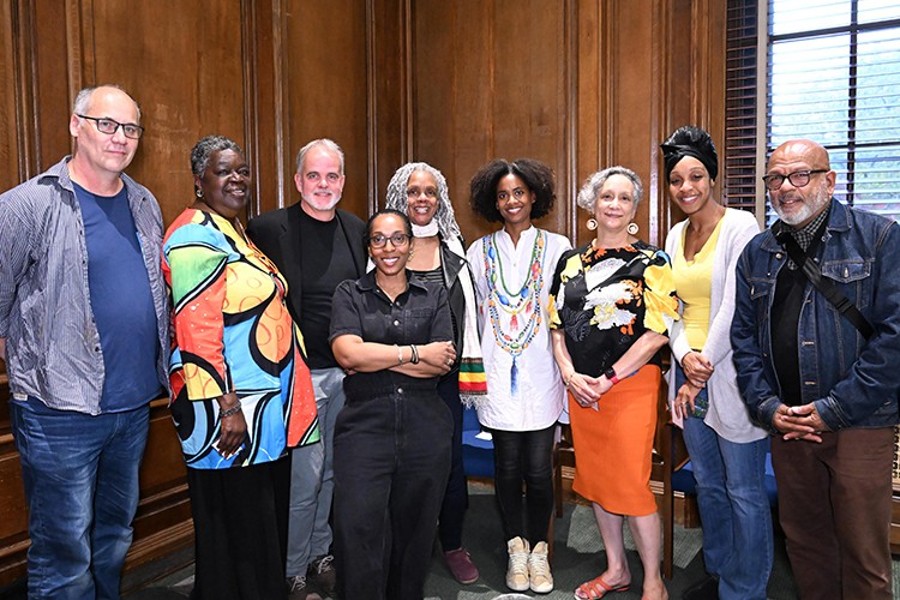 Beginning in September 2017, WE ACT for Environmental Justice organized a growing coalition of more than 40 local community groups, New York City departments and agencies, and elected officials to develop a set of community-driven recommendations that could leverage the Second Avenue Subway extension as an opportunity to help turn East Harlem’s neglected 125th Street into a more environmentally and economically sustainable area. While Central and West Harlem’s sections of 125th Street have enjoyed relative success, El Barrio’s main artery has fallen victim to civic neglect, underinvestment, and short-sighted planning from the public and private sectors. With the upcoming subway extension, and on the heels of the rezoning, the coalition recognized the opportunity to address these issues with community input.
Beginning in September 2017, WE ACT for Environmental Justice organized a growing coalition of more than 40 local community groups, New York City departments and agencies, and elected officials to develop a set of community-driven recommendations that could leverage the Second Avenue Subway extension as an opportunity to help turn East Harlem’s neglected 125th Street into a more environmentally and economically sustainable area. While Central and West Harlem’s sections of 125th Street have enjoyed relative success, El Barrio’s main artery has fallen victim to civic neglect, underinvestment, and short-sighted planning from the public and private sectors. With the upcoming subway extension, and on the heels of the rezoning, the coalition recognized the opportunity to address these issues with community input.
“The expansion of the Second Avenue Subway and the transformation that will accompany it present an opportunity to improve the overall health and resiliency of the neighborhood,” said Peggy Shepard, Co-Founder and Executive Director of WE ACT for Environmental Justice. “By giving the community a strong voice in the redevelopment of the area, particularly along the high-profile East 125th Street corridor, the City can ensure that the neighborhood emerges stronger both environmentally and economically without sacrificing the character and sense of community that has inspired generations to call it home.”
Second Avenue Subway Phase II
The extension of the Second Avenue Subway line will serve as an inviting incentive for developers, bringing another public transit option to the neighborhood. In fact, the 2017 East Harlem rezoning and Federal “opportunity zone” tax breaks have already attracted a number of them, with the Durst Organization, Extell Development, and the Richman Group among those who have begun buying up real estate in the area.
According to the New York Metropolitan Transit Authority (MTA), the Second Avenue Subway Phase II extension will extend the Q line approximately 1.5 miles into the heart of East Harlem / El Barrio from its current terminus at 96th Street and Second Avenue, displacing 136,423 square feet of property (the equivalent of 2.3 football fields) along with more than 400 jobs. The estimated $6 billion project will take the line northwards along Second Avenue before turning west on East 125th Street, where it will terminate at Park Avenue and 125th Street, near the existing Metro-North Station.
According to the New York Metropolitan Transit Authority (MTA), the Second Avenue Subway Phase II extension will extend the Q line approximately 1.5 miles into the heart of East Harlem / El Barrio from its current terminus at 96th Street and Second Avenue, displacing 136,423 square feet of property (the equivalent of 2.3 football fields) along with more than 400 jobs. The estimated $6 billion project will take the line northwards along Second Avenue before turning west on East 125th Street, where it will terminate at Park Avenue and 125th Street, near the existing Metro-North Station.
As East Harlem is primarily a residential neighborhood of low- and moderate-income New Yorkers, including many immigrants and people of color, it is likely that this development will lead to large-scale gentrification, pushing out local businesses and long-time residents while destroying the area’s historical character and culture. That is why WE ACT began developing a broad and inclusive coalition in September 2017, to produce a comprehensive series of recommendations that could serve as a guide to focus this impending development, ensuring that it takes into consideration the needs and interests of the local community.
Recommendations for East Harlem
Over the course of nine months, the coalition – led by the 125th Street Metro-North Transit Hub Steering Committee – conducted an extensive community engagement process that engaged more than 400 East Harlem community members and stakeholders, including residents, public transit users, small business owners, and workers. The effort involved a community visioning charrette, a survey of residents and business owners, and two town hall meetings.
The plan recommends a number of capital projects and policies that address the concerns and advance the interests of East Harlem residents, business owners, and other stakeholders. These recommendations include making East 125th Street an accessible and efficient transit center that better serves community and commuter needs; stimulating the local economy; enhancing social services; promoting environmental resiliency and sustainability; and creating fair and vibrant public spaces to support the community’s social, economic, and cultural needs.
Based on this community input, and with technical assistance from Farzana Gandhi Design Studio, WE ACT completed the East 125th Community Visioning Action Plan, which reflects the four areas of focus raised by the community: 1) Arts and Culture, 2) Transit and the Environment, 3) Jobs and Small Business, and 4) Social and Survival Services. The plan recommends a number of capital projects and policies that address the concerns and advance the interests of East Harlem residents, business owners, and other stakeholders. These recommendations include making East 125th Street an accessible and efficient transit center that better serves community and commuter needs; stimulating the local economy; enhancing social services; promoting environmental resiliency and sustainability; and creating fair and vibrant public spaces to support the community’s social, economic, and cultural needs.
Adding bioswales and permeable pavers to improve stormwater management and surface runoff. Reuse of the old 125 Street and Park Avenue railroad station for cultural and economic enetrprises. Promoting green roofs and solar panel installations to improve energy efficiency, reduce greenhouse gas emissions, and create an opportunity to develop green jobs for local residents. And expanding sidewalks and adding bike lanes to encourage more active lifestyles.
Some of the specific recommendations include introducing additional trees and plantings to reduce the urban heat island effect, improve air quality, and create a buffer between pedestrians and vehicle traffic. Adding bioswales and permeable pavers to improve stormwater management and surface runoff. Reuse of the old 125 Street and Park Avenue railroad station for cultural and economic enetrprises. Promoting green roofs and solar panel installations to improve energy efficiency, reduce greenhouse gas emissions, and create an opportunity to develop green jobs for local residents. And expanding sidewalks and adding bike lanes to encourage more active lifestyles.
“Between the rezoning and the subway extension, there is no question as to whether these changes are happening. But if the City, MTA, and others follow the community’s recommendations outlined in this report, El Barrio should emerge as a thriving neighborhood – strengthened socially, economically, and culturally – instead of being bulldozed for the benefit of a few developers at the expense of long-time residents and businesses.”
“With the release of this report, we hope to center equity and sustainability in conversations about development along East Harlem’s 125th Street corridor,” explained Michael Velarde, Director of Special Projects at WE ACT for Environmental Justice, who manages the initiative. “Between the rezoning and the subway extension, there is no question as to whether these changes are happening. But if the City, MTA, and others follow the community’s recommendations outlined in this report, El Barrio should emerge as a thriving neighborhood – strengthened socially, economically, and culturally – instead of being bulldozed for the benefit of a few developers at the expense of long-time residents and businesses.”
What they have said
New York State Senator José M. Serrano: “The extension of the Second Avenue Subway presents a unique opportunity for growth and revitalization in East Harlem’s 125th Street corridor. However, it’s important that this growth be community-oriented, equitable, and with an eye toward sustainability. After months of community dialogue and stakeholder collaboration, WE ACT’s Community Visioning Action Plan supports a collective vision for the thriving, vibrant neighborhood hub that East Harlem deserves.”
“Development that is fair and provides real benefits for our community is essential for us continue to thrive. I thank WE ACT for their collaborative efforts on behalf of East Harlem. Together, we will ensure that our community is accessible, efficient, and resilient.”
New York State Assemblymember Robert J. Rodriguez: “Development that is fair and provides real benefits for our community is essential for us continue to thrive. I thank WE ACT for their collaborative efforts on behalf of East Harlem. Together, we will ensure that our community is accessible, efficient, and resilient.”
“East 125th Street is full of untapped potential. WE ACT has my thanks for coming up with a bold plan that both addresses areas of concern raised by community members and has potential to transform the neglected 125th Street corridor and provide East Harlem residents with the vibrant public space they deserve.”
Manhattan Borough President Gale A. Brewer: “East 125th Street is full of untapped potential. WE ACT has my thanks for coming up with a bold plan that both addresses areas of concern raised by community members and has potential to transform the neglected 125th Street corridor and provide East Harlem residents with the vibrant public space they deserve.”
New York City Council Member Diana Ayala: “The expansion of the 2nd Avenue Subway and creation of new real estate on East 125th Street is bound to radically transform the corridor. This transformation can be positive if the development is informed by our community and aligned with our residential, economic, and environmental needs. Undoubtedly, East Harlem has been subjected to rapid gentrification and displacement, but a community vision for East 125th Street can help us mitigate these patterns. I thank WE ACT and members of the Steering Committee for engaging in a comprehensive community engagement process and collaborating to create a framework to preserve our community’s culture and history amid future development.”
LSA Family Health Service Director of Programs & Director of Environmental Health Services Ray López: “Community input is essential to ensuring equitable development of the East 125th Street corridor. The Visioning Action Plan reflects a truly inclusive effort. Its recommendations voice the desires of the community for a revitalized East 125th Street that benefits everyone.”
“The release of the community visioning recommendations for the East 125th Street corridor is an important next step in shining a light on the rich history of this area. Ascendant is excited to partner with WE ACT and other local stakeholders that are working to ensure that the historic resources along this corridor are the foundation upon which we build the area’s bright future.”
Ascendant Neighborhood Development Corporation Executive Director & President Christopher Cirillo: “The release of the community visioning recommendations for the East 125th Street corridor is an important next step in shining a light on the rich history of this area. Ascendant is excited to partner with WE ACT and other local stakeholders that are working to ensure that the historic resources along this corridor are the foundation upon which we build the area’s bright future.”
“Done right, the 125th Street Metro-North Transit Hub is a chance to better connect East Harlem to opportunities like jobs and schools, as well as build a healthier community for residents and businesses. With Phase II of the Second Avenue Subway planned to bring new rail service to the neighborhood in the next decade, it’s important that we modernize our local streets too. Tri-State supports the expansion of dedicated bus lanes, curb extensions, and new pedestrian plazas to help achieve these goals.”
Tri-State Transportation Campaign Executive Director Nick Sifuentes: “Done right, the 125th Street Metro-North Transit Hub is a chance to better connect East Harlem to opportunities like jobs and schools, as well as build a healthier community for residents and businesses. With Phase II of the Second Avenue Subway planned to bring new rail service to the neighborhood in the next decade, it’s important that we modernize our local streets too. Tri-State supports the expansion of dedicated bus lanes, curb extensions, and new pedestrian plazas to help achieve these goals.”
Caribbean Cultural Center African Diaspora Institute Executive Director Melody Capote: “East Harlem / El Barrio has long been an important home for people of the African Diaspora. Through our small business entrepreneurship, community leadership, and vibrant artistic and cultural traditions, many diverse Afro-descendent communities from around the world have made El Barrio home. They have settled here, recreated the sense of home, community and family in a space that has come to be known as Nuestro Querido Barrio in NYC. Yet in the attempts to ‘redevelop’ this area, the voices, contributions and narrative of the people have been excluded. With the East 125th Street corridor facing another wave of development and yes let’s call it what it is, gentrification, the Caribbean Cultural Center African Diaspora Institute (CCCADI) remains committed to supporting efforts like this community vision plan that positions and empowers the people of El Barrio. From our historic Firehouse location on East 125th Street, we will continue to preserve, celebrate, and nurture the unique multi-cultural history and identity of East Harlem long into the future and be the mirror of a community that will always be recognized for its contributions and accomplishments in this neighborhood. CCCADI is the place to document and tell our stories in our own voice. It is our expectation that partnerships with developers and businesses coming into our community will do so in the true spirit of collaboration, working in tandem with our vision plan to assure the inclusion of local artists, historians, leaders and representatives of El Barrio as active participants at this time of change.”
“Marcus Garvey Park hosts arts and cultural programming spring through fall that draws a steady stream of people entering the park from the 125th Street corridor. East 125th Street is a vital link to the creative culture that the neighborhoods of Harlem are famous for, the African Burial Ground and the Caribbean Cultural Center at the eastern end of the corridor and the National Black Theater and the Richard Rodgers Amphitheater in Marcus Garvey Park to the west. Serving on the steering committee, I heard the recurring themes of preserving cultural identity and creating opportunities for local artists, throughout the 18 months long process. As the curator for the Public Art Initiative and President of the Marcus Garvey Park Alliance this theme resonates with our mission to address cultural equity….”
Marcus Garvey Park Alliance President Connie Lee: “Marcus Garvey Park hosts arts and cultural programming spring through fall that draws a steady stream of people entering the park from the 125th Street corridor. East 125th Street is a vital link to the creative culture that the neighborhoods of Harlem are famous for, the African Burial Ground and the Caribbean Cultural Center at the eastern end of the corridor and the National Black Theater and the Richard Rodgers Amphitheater in Marcus Garvey Park to the west. Serving on the steering committee, I heard the recurring themes of preserving cultural identity and creating opportunities for local artists, throughout the 18 months long process. As the curator for the Public Art Initiative and President of the Marcus Garvey Park Alliance this theme resonates with our mission to address cultural equity. Respectful and successful development along the corridor will incorporate arts and cultural spaces and will also include art that reflects the community into the design of its public spaces.”
New York Harm Reduction Educators Director of Programs Junior Bazile: “As an Agency that has been serving desperate, neglected and marginalized people who use drugs and are involved in sex work, New York Harm Reduction Educators (NYHRE) has been part of the community that lives, works, or transits through the East 125th Street for many years. We are here to stay, and to continue accompanying this community by providing them with the services that they need. We want to see a positive change that will better accommodate the community that exist around the East 125th Street. Every individual should be thought of and included in the positive change process. No one should be excluded or pushed away.”
WE ACT for Environmental Justice is a Northern Manhattan membership-based organization whose mission is to build healthy communities by ensuring that people of color and/or low-income residents participate meaningfully in the creation of sound and fair environmental health and protection policies and practices. WE ACT has offices in New York and Washington, D.C. Visit us at weact.org and follow us on Facebook, Twitter, and Instagram.
Become a Harlem Insider!
By submitting this form, you are consenting to receive marketing emails from: Harlem World Magazine, 2521 1/2 west 42nd street, Los Angeles, CA, 90008, https://www.harlemworldmagazine.com. You can revoke your consent to receive emails at any time by using the SafeUnsubscribe® link, found at the bottom of every email. Emails are serviced by Constant Contact








